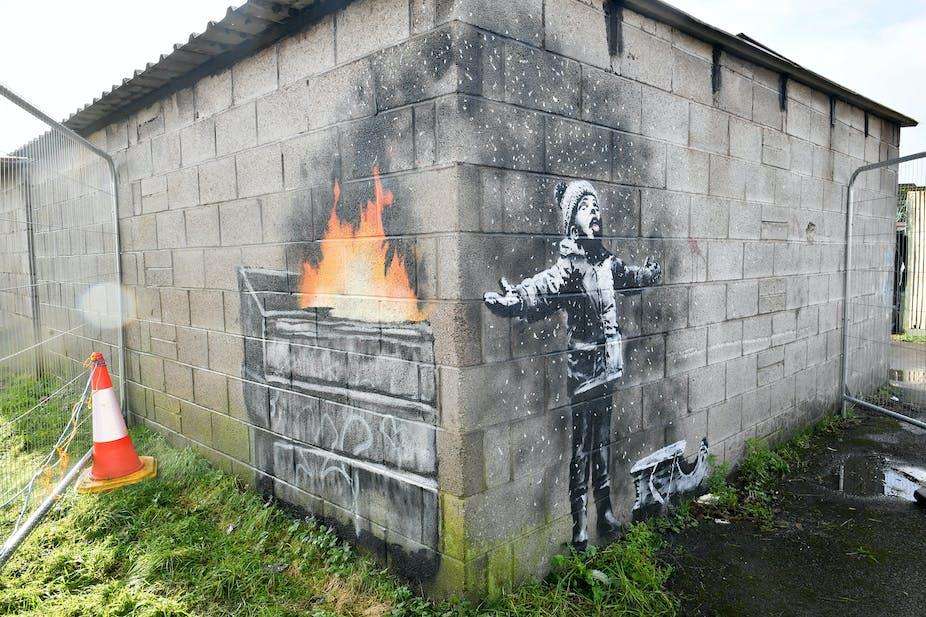The example of controversial art that I chose is Banksy’s Season’s Greetings. When it originally emerged on the outside of a steelworker’s private garage in Taibach, Port Talbot, in December 2018, the painting had to be fenced, as it quickly became popular. Season’s Greetings features a child on a sled dressed in winter garb looking up and extending his tongue out to collect falling snowflakes. The second half of the image, which is painted around a corner, portrays a dumpster fire spewing smoke and ash. The intersection is crucial in emphasizing to the spectator how clueless the child is about his situation.

Banksy is a trailblazer in both the graffiti and traditional art realms, pushing the bounds of what graffiti can be and express. As a result, his work has intrinsic, inventive, and commercial worth. The social message of this art is that the impact of pollution is unnoticed yet crucial for the youngest generations (Mitman, 2019). If the town’s pollution is not addressed, it will be the children who bear the consequences. The aesthetic value of Season’s Greetings is that the artist experimented with the building’s corner to create a perspective game, as seen in Figure 1. Eventually, the graffiti was recognized for its aesthetic worth and preserved so that the public now has an opportunity to see it in museums. As a young member of society, I clearly see that people in my daily life are already facing the hazardous consequences of pollution through increased disease rates.
Even though Banksy is known for his controversial pieces of graffiti, Season’s Greetings has not been censored and has drawn interest from the locals. After art dealer John Brandler purchased the artwork, the Welsh Government eventually paid to have it moved to an empty store so the public could see it (Martin, 2018).
While it is understandable that not every drawing can be left untouched, it is critical that art such as Banksy’s works is not censored by governments. The destruction of paintings that bring attention to vital social issues and possess solid artistic value is never justified. Banksy’s worth is produced by his work’s critical reflection of reality and how it projects onto the audience. Season’s Greetings immediately drew hundreds of tourists to town and sparked so much interest that art dealer John Brandler paid a six-figure amount for it (Mitman, 2019). Due to the public’s reaction on social media platforms, it effectively portrayed its message.
Art definitions might change because various individuals have different ideas about what art should be. Banksy strives to put a vital meaning to his works and let them speak instead of giving any commentary, as he remains anonymous and does not give any interviews. Critics believe that Banksy’s works are artistic due to the social statements they carry and the way they portray reality (Zabawa-Krzypkowska & Groń, 2020). Therefore, the person looking at the art should gaze at it for a longer period and in more detail. The essential and universal trait of art is crafting—the skillful structuring of some medium (Martin, 2018). In this case, even though Season’s Greetings is graffiti, it can be considered Street Art. Moreover, Street Art appeared as a continuation of Popular Art. Martin (2018) refers term ‘popular art’ as current works that are popular among the general public. In addition, considering art explains and illuminates some subject matter, Banksy’s Season’s Greetings can be counted as Art.
In conclusion, Banksy’s Season’s Greetings is an excellent representation of a political statement on a critical social issue. His works draw attention from all parts of the globe due to their artistic value and representation of reality. Controversies that the artist raises are essential to create a call to action among the public. Banksy, who remains anonymous to this day, eloquently delivers his stance on many problems of modern society through a unique way of communication.
References
Martin, F. D. (2018). Humanities through the Arts (10th ed.). McGraw-Hill Higher Education (US). Web.
Mitman, T. (2019). Banksy: Graffiti has become more valuable for what it is than what it says. The Conversation. Web.
Zabawa-Krzypkowska, J., & Groń, K. (2020). Art in the public space, different aspects of artistic activities in architecture. IOP Conference Series: Materials Science and Engineering, 960(3). Web.